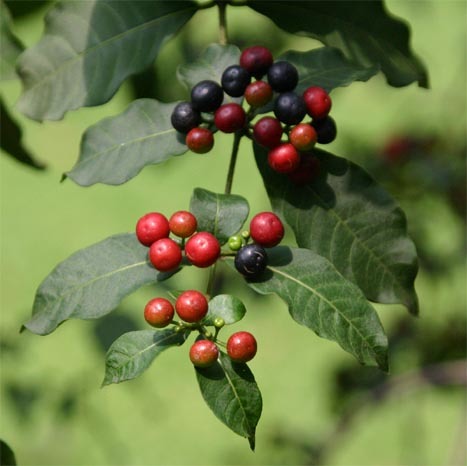Rauwolfia vomitoria Azfel.
| Botanical Name | Rauwolfia vomitoria Azfel. |
| Order: | Gentianales |
| Family: | Apocynaceae |
| Genus: | Rauvolfia |
| Species: | R. vomitoria |
| Common Names: | Swizzlestick, African Rauwolfia (English), Rauwolfia emetique (French). |
Plant Synonyms
Rauvolfia senegambiae A DC; Hylacium owariense P. Beauv
Plant Local Names
Burkina Faso: Dioula - Kolidjohkhi, Fulfulde - Moyatjalal;Ligere
Ghana: Akan - Kakapenpen; Ewe - Dodemak Powoe; Hausa - Wada
Mali: Bambara - Kolijoi
Nigeria: Yoruba - Asofeiyeje
Togo: Ewe - Ou Adja, Dodemakpowoe; Akposso - llonotchi, Oklubete;
Senegal: Diola - Gi Upa
Plant Habitat
The plant occurs naturally in gallery forests but mostly in forest regrowth where fallow periods are prolonged. R. vomitoria is native to Cameroon, Democratic Republic of Congo, Ghana, Liberia, Nigeria, Senegal, Sudan and Uganda, but now cultivated in many tropical and subtropical countries.
Plant Material of Interest
Root, Stem bark
Plant Description
A shrub or small tree up to 15 m high, with dichotomous branching; leaves whorled in groups of 4 or 5, variable, shape ovate, elliptic or oblong, apex acuminate, base cuneate, glabrous, lateral veins 10-16 pairs; terminal inflorescence; flowered corymbs; small white flowers, 3-4 at node, numerous; fruit green, red when ripe (GHP, 2007).
Plant Used Parts
Plant Uses
In traditional African medicine, the decoction of the leaves or roots is administered orally to treat mental illness (Iwu, 1993; Costa-Campos et al., 2004). The macerated leaf is used for the treatment of hypertension and fever, and the decoction is used against gonorrhoea, rheumatism, stunted growth, liver diseases, chronic skin diseases and skin parasites (Mesia et al., 2008). A root decoction is used to treat haemorrhoids (Agyare et al., 2009).
Plant Therapeutic Action
Antiplasmodial, antidiabetic; antibacterial; sive, sedative, antibacterial (Pesewu ef 8; Campbell et al., 2006 ; Zihiri et al.,2005).
Plant Precaution for Use
The recommended dose should not be exceeded as this may provoke cholinergic symptoms and renal damage.
Plant Adverse Effect
Hypotension, hypoglycaemia, bradycardia, diarrhoea, nasal congestion, intestinal upsets.
Plant Contraindication
Hypotension, heart failure, diarrhoea
Plant Dosage Forms
Decoction; tincture
Plant Dosage
Decoction; 30 g dried sliced and chopped roots and rhizome in 900 ml water; simmer until reduced to 600 ml; 1-3 cups daily (GHP, 2007) Tincture- 1:5 in 50% alcohol, 5 ml three times daily
Plant Storage
Store in a cool dry place away from light
Plant Chromatographic Fingerprint
Analytical TLC on silica gel G60 F254, 0.25 mm layer in petroleum ether (40-60 °C)/chloroform [2:8] , detection in daylight, after spraying with anisaldehyde (0.5 ml) mixed with 10 ml glacial acetic acid, 85 ml methanol and 5 ml concentrated sulphuric acid and heated to 100- 110°C for 5-10 min. Presence of three characteristic spots with Rfs 0.69 (pink), 0.50 (pink) and 0.22 (blue).
Plant Constituents
Alkaloids (reserpine, rescinnamine, serpentine, reserpoxidine, seredine, ajmaline, alstonine, iso- ajmaline, isoreserpiline, serpagine, raumatorine,. rauvomitine, reserpiline, vomalidine, yohimbine, tetraphylline) and flavonoids (African pharmacopoeia 1985; Iwu and 1982; Paris, 1943; Amer and Court, 1980; Iwu and Court, 1982).
Plant References
Agyare, C., Asase, A., Lechtenberg, M., Niehues, M., Deters, A., Hensel, A. (2009). An ethnopharmacological survey and in vitro confirmation of ethnopharmacological use of medicinal plants used for wound healing in Bosomtwi-Atwima-Kwanwoma area, Ghana. Journal of Ethnopharmacology 125:393-403.
Amer, M.M. and Court, W.E. (1980). Leaf alkaloids of Rauwolfia vomitoria. Phytochemistry 19:1833-1836.
Campbell, J.I.A., Mortensen, A., Molgaard, P. (2006). Tissue lipid lowering-effect of a traditional Nigerian anti-diabetic infusion of Rauwolfia vomitoria foilage and Citrus aurantium fruit. Journal of Ethnopharmacology 104:379-386.
Costa-Campos, L., Iwu, M., Elisabetsky E.,
(2004). Lack of pro-convulsant activity of the
antipsychotic alkaloid alstonine. Journal of Ethnopharmacology 93:307-310.
Fattorusso, V. and Ritter, O. (1967). Dictionnaire de Pharmacologic Clinique. Mason, Paris, cited by Oliver-Bever, 1986.
Ghana Herbal Pharmacopoeia (2007). 208-212, The Advent Press: Accra, Ghana.
Hage, S., Kienlen-Campard, P., Octave, J.N., Quetin-Leclercq, J. (2010). In vitro screening on -amyloid peptide production of plants used in traditional medicine for cognitive disorders. Journal of Ethnopharmacology 131:585-59.
Iwu, M.M. (1993). Handbook of African Medicinal Plants. Boca Raton, FL, CRC Press Inc., pp. 219-220.
Iwu, M.M. and Court, W.E. (1982). Stem bark alkaloids of Rauwolfia vomitoria. Planta Medica 45, 105-111.
La Barre, J. (1973). Hypotensive effects of the completely dereserpinised extract of Rauwolfia vomitoria. Arzneimittel-forschung 23:600-605.
Mesia, G.K., Tona, T.H., Nanga, T.H., Cimanga, R.K., Apers, S. et al. (2008). Antiprotozoal and cytotoxic screening of 45 plant extracts from Democratic Republic of Congo. Journal of Ethnopharmacology 115:409-415.
Mshana, N.R., Abbiw, D.K., Addae-Mensah, I., Ahiyi, M.R.A., Ekper, J.A., et al., (2000). Traditional medicine and pharmacopoeia. Contribution to the revision of Ethnobotanical and Floristics Studies of Ghana. Organisation of African Unity/Scientific, technical and research committee.


